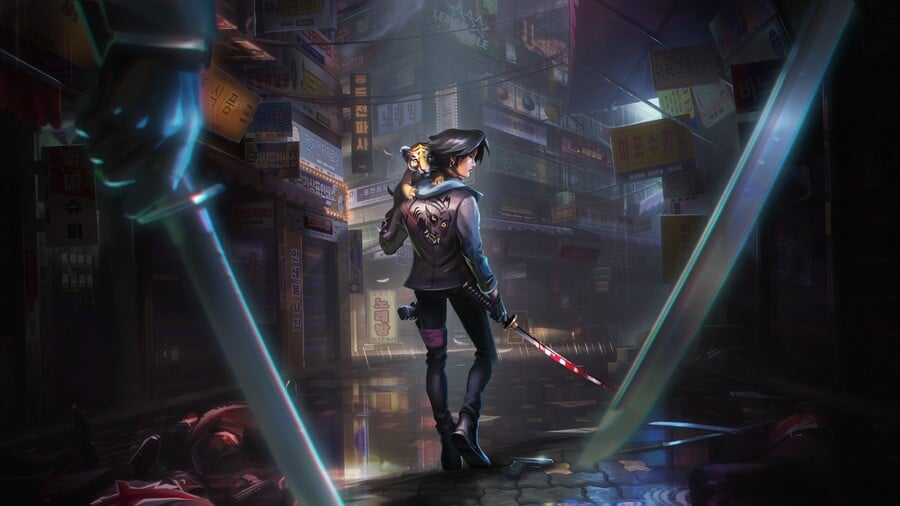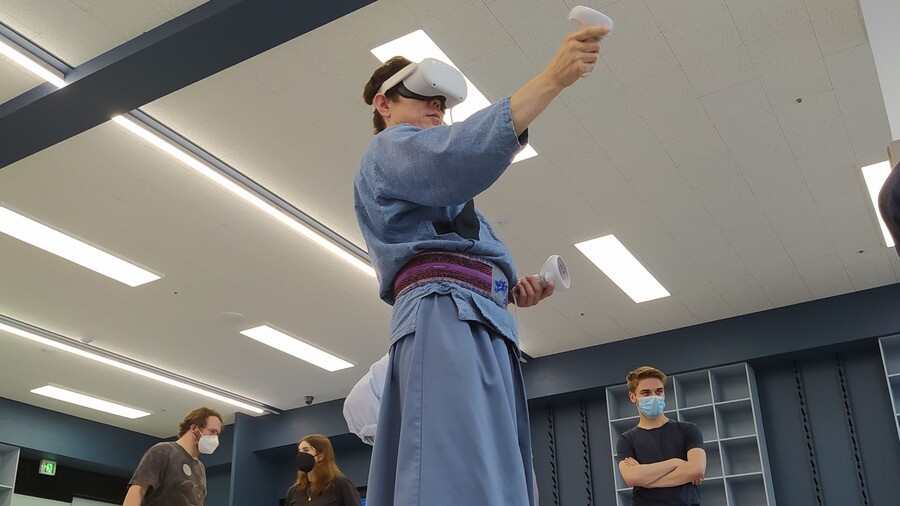
With its high-octane arcade gameplay and strong Korean influences, Tiger Blade caught our attention when it was announced for PSVR2 recently. In development at Parisian outfit Ikimasho, the game sees you slashing and blasting your way through waves of hoodlums as you're tasked with stealing a mysterious package containing a mythical tiger cub believed extinct for hundreds of years. We were eager to learn a little more about the project, including its exciting K-hip-hop soundtrack, so we caught up with co-founder Yann Suquet and CTO Chérif Younis to learn a little more about its influences, its night-time research trips across Seoul, and the musicians it’s collaborating with.
You're a Parisian studio, so what did you find appealing about Korea and specifically its style of cinema that made you want to design Tiger Blade around it?
 Watch on YouTube
Watch on YouTubeSubscribe to Push Square on YouTube167k
Yann Suquet: The ambience of Korean neo-noir cinema is incredibly powerful. The combination of physical brutality — in sword and gun fights — with the darkness of its stories of treason and revenge are what we love about it. Some of our main inspirations were A Bittersweet Life, Man on High Heels, The Villainess, A Man from Nowhere, and My Name.
At Ikimasho, we make action games and pay particular attention to the immersion of the setting, so creating an homage to that genre was irresistible to us.
You say that Tiger Blade's setting has been meticulously recreated. Can you talk a little bit about what kind of research went into making the locations look and feel real?
Suquet: Tiger Blade delivers an original story in a fictional setting that heavily draws from Korea. It looks the part, but the rules are different, seen through the lens of the game's creative impetus. To render the immersion as best as we could, we took the entire art and design team on a location-scouting trip to Korea to immerse ourselves into all the environments that would then inspire Tiger Blade’s settings.
We approached this as you would when producing a movie: we reached out to Film Korea and the Seoul Film Commission and presented them with the settings we wanted in the game: a container harbour, a maze of dark, narrow streets, a financial district… They put us in contact with a fantastic team of local location scouters with whom we narrowed down the various locations across the country that fit our needs: the maze behind Sewoon Sangga, the port of Gwangyang, the Hyundai Seoul. And then they took us there by night since the game’s story arc unfolds over one fateful night (and which actually helped with jet-lag). We shot 150GB+ of picture, video, and sound footage which acts as a reference for 90 per cent of the assets in the game.
One thing we couldn’t take as is were the storefronts, our absolute favorite being the biggest bakery chain in Korea: Paris Baguette. We had a fun time twisting these brands into new, sometimes quirky ones.
We also wanted the combat to feel genuine, so we visited the Korea Haidong Kumdo Association at their brand new facility that was to open the next day. Haidong Kumdo literally translates to The Korean Way of the Sword and is a martial art with a certain level of flamboyance. While we couldn't reproduce Haidong Kumdo movements 1:1 because their speed and readability are not suited to VR gameplay, they were a great source of inspiration for our sword-fighting combat animation.

Throughout this whole research process, we also benefited from the support of the Korean Cultural Center in Paris, the Paris office of the Korean Creative Content Agency (their mission is to promote Korean content abroad, but they liked Tiger Blade so much they helped us make connections in Korea), and the Cultural Services of the French Embassy in Seoul.
We hope our players will enjoy immersing themselves in Tiger Blade’s world as much as we enjoyed crafting it.
High scores are a huge part of the appeal of Tiger Blade. Can you explain how the scoring system works and what do you think is the essence of making an arcade game like this addictive?
Suquet: I think the addiction to an arcade game comes from a combination of two elements: instant fun and depth. Tiger Blade’s core features of slashing, dashing, and shooting are instantly rewarding. And because they are built into super dynamic moment-to-moment situations, you just crave that rush again and again. After 18 months of development, we are still excited to pick up the headset.
That constant thrill is supported by an engaging ramp-up in difficulty that is challenging while never feeling unfair, and our scoring system. We made different iterations of the scoring system, and throughout our playtests, we observed that the only thing players cared about was beating their own time. So our score is your time plus penalties for each hit taken. Combined with local and global leaderboards, it's tremendously engaging.
In addition, we have completion objectives like “collect all the medallions in the level” which encourages players to search every nook and cranny of the environments and makes them discover cool perspectives they will have probably missed on their first run. Combined, these elements make Tiger Blade a really addictive game.
I'm a big fan of Korean hip-hop and actually was familiar with SINCE, so was excited to see her music included in the announcement trailer. Can you tease any of the other artists involved? CAMO...?
Suquet: That’s great to hear! We wanted a gritty, yet energizing beat to support the gameplay and immersion. We started a Spotify playlist of about 15,000 K-hip-hop tracks and when Tang by SINCE came up, we instantly knew that this was what Tiger Blade needed. We reached out to SINCE and, in parallel, worked with French K-hip-hop expert K.viar to expand our horizons in case that lead fell through.
Regarding CAMO, the Cultural Services of the French Embassy in Seoul had actually recommended her to us because they had just recently brokered a collaboration between her and a French hip-hop artist. I personally like her a lot but her style is a bit too R&B for Tiger Blade.

Fast forward a few months and we are working with Culture Think, SINCE’s management company (and also the organizers of the biggest K-hip-hop festivals in Korea and Asia) to produce our original soundtrack.
We have four absolutely brilliant artists — SINCE, Bryn, Kitsyojii, and Bruno Champman — who each composed two songs in their own unique styles. And Tiger Blade’s theme song is a collaboration between all four of them. We look forward to unveiling our tracks ahead of the game’s release!
What do you think it is about PSVR2 that makes it a suitable platform for Tiger Blade. How have you found working on the headset, and what do you think its future looks like?
Chérif Younis: I will spare you the technical specs of the headset and controllers, you probably know them already! PSVR2 is a class system of its own and Tiger Blade leverages every feature available to enhance the overall gaming experience: the high resolution, the eye-tracked foveation, the texture optimisation, the haptics and trigger effects — all elements that help immerse the player while keeping the most responsive, fastest gameplay possible on the headset. I should add that you must experience the 3D soundscape that we prepared for our players — it’s truly a living world.
Looking ahead, the future of PSVR2 looks bright: developer support is great, and the pace at which Sony enhances SDKs, tools, and adds cutting-edge performance optimisations makes the experience of developing for the platform a real joy. The growing catalogue of games made by the VR dev community shows great, creative use of the hardware and we can’t wait to see what’s coming. This ecosystem will likely make PSVR2 the place to experience the most premium VR experiences and as a long-time Sony fan, it’s a special milestone for us to be part of the PlayStation developer community!
We’d like to thank Yann and Chérif for taking time out of their busy schedules at Ikimasho to share a little more insight into Tiger Blade’s creative process, even going as far as to share reference photos from its trip to Korea. Do you think this striking, high-octane arcade shooter/slasher is going to end up on your PSVR2 wishlist? Strike us down in the comments section below.





Comments 6
So awesome to get the reference photos from the team compared to what they created for the game. Thanks so much to the devs for sharing those with me!
Really looking forward to this!
As a Korean I approve of this project. 🫶
@TrickyDicky99 I'd say the whole point of VR is to use actual motion.......otherwise what's the point ? just my opinion
@Discol76 for me just the ability to look around and being surrounded by the artificial world elevates a game in VR over the flat screen version. Also the 3D sound is better synchronised with the visuals in VR.
I like VR AF games i.e. motion controls with lots of interactive elements, and prefer motion control aiming over thumbstick aiming, but for example hitman 3 on psvr was perfectly fine for me. Playing e.g. hitman 3 with a gamepad is different from playing such a game with motion controls, but it is still much better playing it in VR, and playing with a gamepad is more relaxed.
I would say options are king.
Very nice interview!
The game sounds cool, but I am not yet sold on the visuals. Maybe it looks better in the headset but to me it looks like a blend of a low poly 3D world with 2D effects.
Up to now, I am cautiously interested.
@TrickyDicky99 PSVR 2 is VRAF all the way, as it should be.
Show Comments
Leave A Comment
Hold on there, you need to login to post a comment...